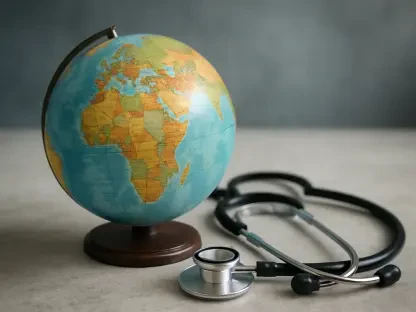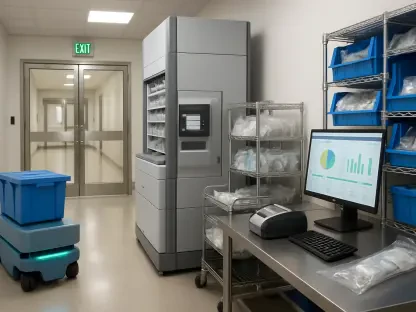The pharmaceutical industry stands at a critical juncture, where the need for robust supply chain transparency and security has never been more urgent, particularly as counterfeit drugs threaten public health on a global scale. Track and trace solutions, encompassing technologies like barcodes and Radio Frequency Identification (RFID), are becoming indispensable tools in monitoring the journey of pharmaceutical products from manufacturer to end user. With a forecast horizon stretching to 2035, this market is poised for significant expansion, driven by regulatory pressures, technological advancements, and an escalating demand for patient safety. The complexity of modern supply chains, coupled with the rising incidence of drug fraud, underscores the urgency for innovative tracking mechanisms. This article explores the key factors propelling the growth of these solutions, delving into technological trends, competitive dynamics, regional variations, and the challenges that lie ahead. By examining these elements, a clearer picture emerges of how the industry will evolve over the next decade to safeguard the integrity of pharmaceutical distribution.
Emerging Technologies and Market Drivers
The growth trajectory of pharmaceutical track and trace solutions through 2035 is heavily influenced by the rapid adoption of cutting-edge technologies that enhance supply chain visibility and security. Digital innovations such as the Internet of Things (IoT), blockchain, and artificial intelligence (AI) are revolutionizing the way data is collected, analyzed, and protected across complex networks. Blockchain technology, for instance, offers an immutable ledger that ensures the authenticity of product movement records, effectively combating fraud and eliminating data silos. This shift toward digitalization is not merely a trend but a necessity, as the industry grapples with increasingly sophisticated counterfeit schemes. Regulatory mandates, such as the Drug Supply Chain Security Act (DSCSA) in the United States, further amplify the push for advanced tracking systems, compelling companies to invest in solutions that guarantee compliance while boosting operational efficiency. As these technologies mature, their integration into mainstream pharmaceutical practices is expected to accelerate market expansion significantly.
Another critical driver shaping this market is the escalating demand for real-time data access to ensure product integrity throughout the supply chain. The complexity of modern pharmaceutical products, particularly biologics, necessitates precise monitoring to maintain quality and safety standards during storage and transportation. Track and trace solutions equipped with IoT capabilities enable stakeholders to track environmental conditions like temperature and humidity, mitigating risks of spoilage or tampering. Additionally, the global rise in healthcare expenditure fuels the need for reliable systems that can handle larger volumes of pharmaceutical goods without compromising security. Governments and international bodies are also tightening regulations to curb the proliferation of counterfeit drugs, positioning compliance as both a legal requirement and a competitive advantage. Companies that proactively adopt these technologies stand to build trust with consumers and regulators alike, carving out a stronger foothold in an increasingly crowded market over the coming years.
Competitive Dynamics and Strategic Moves
The competitive landscape of pharmaceutical track and trace solutions is vibrant, with industry leaders like Optel Vision, Siemens, IBM, and TraceLink spearheading innovation and market growth. These companies are not only developing advanced technologies but also engaging in strategic partnerships, mergers, and acquisitions to broaden their reach and enhance their offerings. By tailoring solutions to meet the specific needs of diverse sectors such as Bio Pharma, Chemical Pharma, and Specialty Pharma, these players address unique challenges like the stringent handling requirements for biologics. The emphasis on product differentiation is evident as firms invest in research and development to introduce features like enhanced data analytics and seamless integration with existing systems. This competitive fervor is set to intensify through 2035, as companies vie for market share by aligning their strategies with evolving regulatory and technological landscapes, ultimately driving the adoption of more sophisticated tracking mechanisms.
Geographic expansion also plays a pivotal role in the strategies of these market leaders, as they seek to tap into emerging economies with burgeoning pharmaceutical industries. Collaborations with local manufacturers and distributors enable these firms to customize solutions that comply with regional regulations while addressing specific supply chain vulnerabilities. The focus on mergers and acquisitions allows for the rapid assimilation of innovative technologies and expertise, strengthening their competitive edge. Moreover, the push toward interoperability—ensuring that track and trace systems work cohesively across different platforms and stakeholders—remains a priority, as fragmented systems can undermine efficiency. As the market evolves, the ability of these companies to anticipate and adapt to industry needs, whether through groundbreaking product launches or strategic alliances, will be crucial in maintaining leadership positions and fostering widespread adoption of track and trace solutions globally by 2035.
Regional Variations and Growth Potential
Regional dynamics significantly influence the adoption and growth of pharmaceutical track and trace solutions, with distinct patterns emerging across different geographies. North America and Europe currently lead the market, thanks to their advanced healthcare infrastructure and stringent regulatory frameworks that mandate comprehensive tracking systems. In the United States, for instance, compliance with the DSCSA has driven widespread implementation of technologies like RFID and barcodes to ensure product traceability. Similarly, European nations adhere to rigorous standards that prioritize patient safety and supply chain transparency. These regions benefit from established technological ecosystems and high levels of investment, which facilitate the rapid deployment of innovative solutions. However, maintaining this leadership will depend on continuous adaptation to emerging threats like cyber fraud and the integration of next-generation technologies to stay ahead of regulatory curves through 2035.
In contrast, the Asia-Pacific region emerges as a hotspot for exponential growth in this sector, propelled by rapid industrialization and increasing pharmaceutical production. Countries in this area are witnessing a surge in healthcare spending, alongside government initiatives aimed at combating the pervasive issue of counterfeit drugs. While the region lags behind North America and Europe in terms of infrastructure, the potential for market expansion is immense, driven by a growing middle class and heightened demand for quality healthcare. Tailoring solutions to local conditions—such as varying regulatory requirements and logistical challenges—will be essential for technology providers looking to capitalize on these opportunities. As investments pour into upgrading supply chain capabilities, Asia-Pacific is expected to become a critical battleground for track and trace solution providers, shaping global market trends significantly by 2035.
Obstacles and Pathways Forward
Despite the promising outlook for pharmaceutical track and trace solutions, several challenges loom large on the path to 2035, potentially hindering widespread adoption if not addressed. High implementation costs pose a significant barrier, particularly for smaller pharmaceutical companies that may lack the capital to invest in sophisticated systems like RFID or blockchain. Additionally, concerns over data privacy and cybersecurity are mounting, as the digitization of supply chains increases the risk of breaches that could compromise sensitive information. The absence of global standardization further complicates matters, as disparate systems across regions hinder interoperability and create inefficiencies. Tackling these issues will require concerted efforts from industry stakeholders to develop cost-effective solutions and robust security protocols that protect data while ensuring compliance with diverse regulatory landscapes.
Looking ahead, the future of this market hinges on fostering collaboration among technology providers, pharmaceutical firms, and regulatory bodies to create cohesive, interoperable systems. Investments in innovation must prioritize scalable solutions that lower entry barriers for smaller players while addressing privacy concerns through advanced encryption and secure data-sharing frameworks. Establishing global standards for track and trace technologies will be paramount to streamline operations across borders and enhance supply chain resilience. Partnerships that bring together expertise from various sectors can accelerate the development of standardized protocols, ensuring seamless integration and real-time data access. As the industry progresses toward 2035, sustained commitment to overcoming these hurdles through strategic alliances and technological breakthroughs will be vital to safeguarding the integrity of pharmaceutical distribution networks worldwide.









